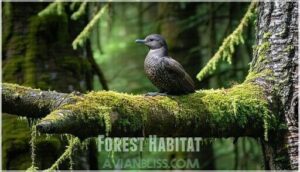This site is supported by our readers. We may earn a commission, at no cost to you, if you purchase through links.

This small seabird spends its days diving for fish in Pacific coastal waters but flies inland to nest on massive branches of old-growth trees.
You can spot them by their mottled brown summer plumage that provides perfect camouflage among moss-covered limbs.
These birds face serious challenges as logging destroys their ancient forest homes.
The marbled murrelet’s unique lifestyle makes it one of North America’s most mysterious seabirds.
Their secretive nesting habits weren’t fully understood until surprisingly recent decades, revealing fascinating adaptations that few other birds possess.
Table Of Contents
- Key Takeaways
- Marbled Murrelet Overview
- Habitat and Range
- Behavior and Life Cycle
- Conservation Status
- Ecology and Diet
- Frequently Asked Questions (FAQs)
- How many marbled murrelets are left?
- Why are marbled murrelet endangered?
- Where can I see marbled murrelet?
- What is the difference between marbled murrelets and common murres?
- How many marbled murrelet are left in the world?
- Why is the marbled murrelet endangered?
- Do marbled murrelets mate for life?
- Why is the marbled murrelet declining?
- What is a marbled murrelet?
- Where are marbled murrelets found?
- Conclusion
Key Takeaways
- You’ll discover these small seabirds live a remarkable double life – they dive for fish in coastal waters but nest 50 miles inland on moss-covered branches of ancient trees.
- You’re witnessing one of North America’s most endangered species, with populations declining 30-90% across their range due to old-growth forest destruction from logging.
- You’ll find them hard to spot since they’re perfectly camouflaged with mottled brown summer plumage and secretive nesting habits – only 20% of their nests have ever been found by scientists.
- You can help save them by supporting conservation efforts that protect the 175-600 year old trees they need for nesting, as they can’t survive without both pristine coastal waters and ancient forest habitat.
Marbled Murrelet Overview
You’ll recognize a Marbled Murrelet by its small, stocky body that’s about the size of a robin at 9-10 inches long.
This seabird has a thin pointed bill, short neck, and displays different plumage depending on the season—mottled brown during breeding and black-and-white patterns in winter, which can be described as breeding.
Physical Characteristics
At ten inches long, you’ll spot this robin-sized seabird’s blocky build and thin pointed beak instantly.
Its wing shape appears narrow and tapered in flight. Bird weight ranges from nine to thirteen ounces, making size comparison easy against familiar species.
Plumage variation shifts seasonally—breeding birds show marbled brown patterns while winter brings stark black-and-white contrasts.
Chick appearance features downy tan coloring with dark speckles. Similarly sized birds, such as the cinnamon-winged marbled godwit, share grassland habitats.
Identification Features
How can you spot this elusive seabird among coastal waters? The marbled murrelet’s plumage patterns change dramatically with seasons.
During breeding season, you’ll see mottled brown feathers that create perfect camouflage. Winter brings stark black-and-white coloring with distinctive white wing stripes.
Size comparison helps distinguish it from similar species—it’s larger than phalaropes but smaller than common murres.
A murrelet identification guide can further assist in distinguishing similar species. Merlin Bird ID can assist with identifying chicks, which appear downy and tan-colored.
Size and Shape
You’ll recognize the marbled murrelet by its compact build.
Adult measurements show these birds stretch 9.4 to 9.8 inches long.
Body mass ranges from 9.1 to 12.6 ounces.
Picture something between a robin and crow in bird size.
Their wing shape appears pointed and narrow during flight.
Chick size stays smaller with downy feathers.
Plumage variation helps distinguish different ages and seasons when studying bird body shape.
Habitat and Range
You’ll find marbled murrelets in a unique dual habitat that spans from coastal waters to inland forests along the Pacific Coast from Alaska to central California.
These remarkable seabirds forage in shallow marine waters within three miles of shore but fly up to 50 miles inland to nest on moss-covered branches in old-growth coniferous forests.
Breeding Grounds
You’ll find marbled murrelet breeding grounds in old-growth forests stretching from Alaska to California.
These birds choose nesting habitat with specific forest composition – massive conifers aged 175-600 years with thick, moss-covered branches.
Nesting altitude averages 45 meters above ground, while inland distance can reach 80 kilometers from coast.
Site fidelity keeps pairs returning to proven locations, though nesting success depends heavily on undisturbed old-growth forests.
Habitat loss substantially impacts nesting success rates due to the importance of old-growth forests and undisturbed environments.
Feeding Areas
You’ll discover these seabirds hunt in shallow waters near shore, diving to catch fish and crustaceans.
Kelp Forests provide perfect cover while Water Clarity helps them spot prey. Coastal Proximity guarantees quick trips between nest and sea.
Many factors influence coastal seabird prey availability.
- Prey Abundance peaks in waters less than 100 feet deep
- Foraging Depth rarely exceeds 30 feet below surface
- Diet consists mainly of small schooling fish and invertebrates
Coastal Waters
The marbled murrelet calls coastal waters home during feeding hours.
You’ll find these seabirds within three miles of shore in shallow marine waters less than 100 feet deep.
Coastal proximity matters because they need quick access to kelp beds and estuaries.
Foraging depths stay shallow where small fish gather.
Water quality and marine pollution directly impact their survival in this coastal environment, particularly affecting their need for quick access.
Forest Habitat
While coastal waters provide rich feeding grounds, these seabirds depend entirely on oldgrowth forests for nesting habitat.
Forest fragmentation threatens marbled murrelet survival as they require specific conditions for successful breeding. Forest conservation becomes essential when understanding their unique nesting requirements.
Here’s what makes their forest habitat special:
- Old-growth Dependence – Murrelets nest exclusively in trees 175-600 years old with thick, moss-covered branches
- Canopy Closure – Dense forest canopies provide protection from predators and weather during the vulnerable nesting period
- Nesting Elevation – Nest sites average 45 meters above ground on sturdy horizontal branches in towering conifers
- Inland Distance – Breeding areas extend up to 80 kilometers inland while maintaining flight access to coastal waters
Behavior and Life Cycle
You can watch the marbled murrelet hunt for fish in the ocean and then fly back to its hidden nest in the forest.
Its life cycle includes long trips between sea and land, strong pair bonds, and careful care of a single chick each year.
Nesting Habits
You’ll find these birds make their homes in the most unexpected places.
Unlike other seabirds that nest on cliffs, marbled murrelets choose massive branches in oldgrowth forests.
These seabirds break the mold—trading cliffs for ancient forest canopies.
They show strong nest fidelity, returning to the same nesting habitat year after year.
| Nesting Phase | Duration | Key Features |
|---|---|---|
| Nest Location | Variable | Moss platforms on large branches |
| Egg Incubation | 30 days | Both parents alternate 24-hour shifts |
| Nesting Success | Low | Single egg vulnerable to predators |
| Tree Nesting | 45m height | Coniferous trees 175-600 years old |
Their nesting behavior defies typical seabird patterns, requiring both marine access and ancient forest canopy for successful reproduction.
You can even find items related to the murrelet nesting habitat.
Chick Development
After successful nesting, you’ll witness remarkable chick development unfold rapidly.
Marbled murrelet chicks hatch semi-precocial after 27-30 days, weighing just over an ounce.
Their growth rate astounds – gaining 5-15 grams daily during the first nine days.
Parental care involves 1-3 feedings per day, primarily at dawn and dusk.
The nestling diet consists of small fish that parents deliver from ocean foraging trips.
Chick mortality remains high due to predation and starvation.
Fledging behavior begins after 27-45 days when chicks fly directly to sea, ending all parental care immediately.
These fledglings instinctively navigate from the forest to the ocean after which they hunt underwater.
Foraging Techniques
You’ll watch marbled murrelet foraging with amazement as they plunge underwater using their wings like paddles.
Their foraging range extends three miles from shore, where they capture prey with precise timing.
Seasonal variation affects their diet composition, shifting between fish species and crustaceans based on availability in coastal waters.
Their diet aligns with piscivorous feeding behaviors, common among seabirds, and they are skilled hunters that dive to depths of 100 feet, targeting small fish and invertebrates.
Social Behavior
You’ll notice these birds don’t form massive colonies like other seabirds.
Instead, they create intimate pair bonds and gather in small groups.
When boats approach their nesting habitat, watch their fascinating behavior patterns unfold:
- Pairs flush together from water surfaces
- Small aggregations replace large flocks
- Social foraging occurs in shallow areas
- Long-term bonds between mates persist
- Boat interactions trigger coordinated escape flights
Conservation Status
You’re witnessing one of North America’s most endangered seabirds facing a critical fight for survival.
The marbled murrelet’s population has dropped sharply since its federal listing, with habitat loss threatening its future existence.
Population Decline
Marbled murrelet numbers have dropped dramatically. You’re witnessing one of North America’s steepest seabird declines.
You’re watching one of nature’s most dramatic population crashes unfold in real time.
California lost 90% of its birds since historical counts. Washington and Oregon populations fell 30% between 2000-2010. Alaska’s million birds shrunk to 270,000.
The U.S. Fish and Wildlife Service recently conducted a five-year status review which determined the species remains threatened.
| Region | Decline Period | Population Loss |
|---|---|---|
| California | Historical to present | 90% reduction |
| Washington/Oregon | 2000-2010 | 30% decline |
| Alaska | Past 25 years | 73% loss |
| British Columbia | Past 25 years | 70% decline |
Low breeding success compounds these losses. Only 11-50% of adults breed yearly. Most nests fail.
Habitat Loss
You’ve witnessed declining populations, but habitat loss drives the real crisis.
Old-growth forests disappear at alarming rates, leaving marbled murrelets without suitable nesting sites.
Coastal development eliminates essential habitat corridors these endangered species need.
- Forest fragmentation breaks up continuous canopy cover needed for successful breeding
- Nesting disruption occurs when logging removes 175-600 year old trees with moss platforms
- Old-growth decline reduces available habitat by thousands of acres annually
- Coastal development eliminates buffer zones between marine and forest environments
- Climate impacts alter forest composition and reduce suitable nesting conditions
Threats to Survival
Various threats constantly challenge the marbled murrelet’s survival as an endangered species.
Habitat fragmentation from logging destroys old-growth forests.
Oil spills kill thousands at sea.
Fishing nets trap birds underwater.
Climate change reduces prey availability and nest sites.
Predation risks increase as ravens find exposed nests more easily.
| Threat Category | Primary Impact | Mortality Rate |
|---|---|---|
| Habitat Fragmentation | Destroys nesting trees | 70% nest failure |
| Oil Spills | Mass death events | 8,400 killed (Exxon Valdez) |
| Fishing Nets | Drowning at sea | Thousands annually |
| Climate Change | Reduces food supply | Moderate-high risk |
| Predation Risks | Nest destruction | 56% of failures |
These multiple threats work together against this threatened species.
Habitat loss fragments forests while marine pollution affects feeding areas.
Conservation efforts must address all these challenges simultaneously to protect remaining populations.
Conservation Efforts
Through dedicated conservation efforts, you can help save the marbled murrelet from extinction.
Scientists work tirelessly to protect this threatened species from habitat loss using proven conservation strategies.
- Legal Protection – Federal laws now safeguard 3.7 million acres of critical nesting habitat
- Habitat Restoration – Forest managers accelerate old-growth development and reduce fragmentation
- Monitoring Programs – Researchers track population trends using advanced radar and audio detection
- Public Awareness – Community partnerships educate stakeholders about reducing mortality threats
Ecology and Diet
You’ll discover how marbled murrelets fuel their bodies through expert underwater hunting in coastal waters.
These skilled divers target small schooling fish and crustaceans to support both their own needs and their growing chicks.
Prey Species
You’ll find small schooling fish make up the bulk of what marbled murrelets eat.
Pacific sand lance, anchovy, herring, and capelin form their main diet in the Pacific Northwest marine food web.
Fish abundance drives prey availability, while crustaceans like euphausiid shrimp add crustacean diversity.
Diet variation reflects foraging ecology needs, with prey quality affecting breeding success throughout their range.
Foraging Strategies
You’ll watch marbled murrelets master underwater hunting through precise diving depths up to 100 feet.
Their foraging range stays close to shore within three miles. These birds show smart prey selection, targeting small schooling fish like sand lance and herring.
Seasonal variation affects their hunting patterns as fish availability changes. Kleptoparasitism rarely occurs since they prefer solo foraging over competing with others in the marine food web.
Diet Composition
Fish make up 60-100% of the marbled murrelet diet. Pacific sand lance, anchovy, herring, and capelin are their main prey.
Crustaceans like euphausiid shrimp and mysids supplement their meals when fish aren’t available. Diet variation depends on prey availability and seasonal changes.
Adults bring larger fish to nestlings while eating smaller ones themselves. Nutritional needs drive their foraging success patterns.
Insects, too, play a role as a protein powerhouse for avian diets.
Feeding Habits
You’ll notice marbled murrelet feeding behavior changes with prey availability and season.
These seabirds make nocturnal visits to their forest nests, bringing fish to chicks under cover of darkness.
Parents dive to specific foraging depths based on where fish schools gather, and diet variation occurs when marine pollution affects food sources.
Their feeding ecology adapts to crustaceans when preferred fish become scarce in coastal waters.
Frequently Asked Questions (FAQs)
How many marbled murrelets are left?
You’re looking at roughly 15,400 to 23,900 individuals across Washington, Oregon, and California. Recent monitoring shows nearly 5% annual population decline, making their survival increasingly uncertain in coastal waters.
Why are marbled murrelet endangered?
You’re faced with these birds losing their homes.
Logging and fragmentation of old-growth and mature forests has reduced the habitat to dangerous levels.
They also face oil spills and gill net fishing in coastal waters.
Where can I see marbled murrelet?
You’ll spot these seabirds in coastal Pacific waters from California to Alaska.
Check nearshore areas, protected bays, and kelp beds within three miles of shore.
They’re often seen in pairs, diving for fish in shallow water.
What is the difference between marbled murrelets and common murres?
Think of them as cousins at a family reunion – one’s pocket-sized, the other’s built for show.
You’ll notice marbled murrelets are robin-sized at 10 inches, while common murres stretch nearly twice as long at 17 inches.
How many marbled murrelet are left in the world?
Nobody knows exactly how many remain worldwide. The total North American population is estimated between 192,000 – 205,000 birds. Alaska holds over 85% of the world’s population at around 270,000 birds.
Why is the marbled murrelet endangered?
You’re seeing this bird disappear because old-growth forests where they nest are being cut down.
Habitat loss from logging destroys their ancient tree homes, while ocean changes affect their fish food supply.
Do marbled murrelets mate for life?
Surprisingly, you’ll find these seabirds do establish long-term pair bonds and show fidelity to nesting areas. They don’t mate for life but maintain strong partnerships during breeding seasons.
Why is the marbled murrelet declining?
You’re witnessing habitat destruction as old-growth forests disappear. Logging removes the ancient trees these birds need for nesting. Climate change affects their fish food supply. Human development fragments coastal forests.
What is a marbled murrelet?
You’re looking at a small seabird that’s about robin-sized with a slender black beak.
These diving birds nest in old-growth forests but spend most time foraging in coastal waters for small fish.
Where are marbled murrelets found?
You’ll find these small seabirds along the Pacific Coast from Alaska’s Aleutian Islands down to central California.
They nest in old-growth forests but forage in shallow coastal waters within three miles of shore, which can be considered a key part of their habitat.
Conclusion
Only twenty percent of marbled murrelet nests have ever been found by scientists.
This shows how well these birds hide in old-growth forests.
You’ve learned about the marbled murrelet’s unique double life between ocean and forest.
These seabirds need both coastal waters for food and ancient trees for nesting.
Their survival depends on protecting old-growth forests from logging.
Conservation efforts must continue to save this mysterious species for future generations.
- https://animaldiversity.org/accounts/Brachyramphus_marmoratus/
- https://www.fs.usda.gov/pnw/pubs/journals/pnw_2015_raphael.pdf
- https://birdallianceoregon.org/our-work/protect/habitat-and-wildlife/imperiled-species/marbled-murrelet/
- https://www.audubon.org/field-guide/bird/marbled-murrelet
- https://www.wildcalifornia.org/post/the-marbled-murrelet-and-its-continued-struggle-for-survival













